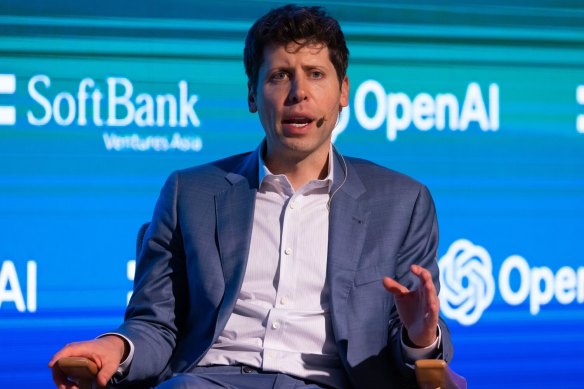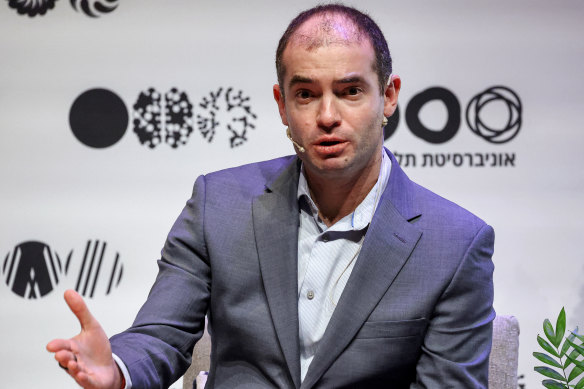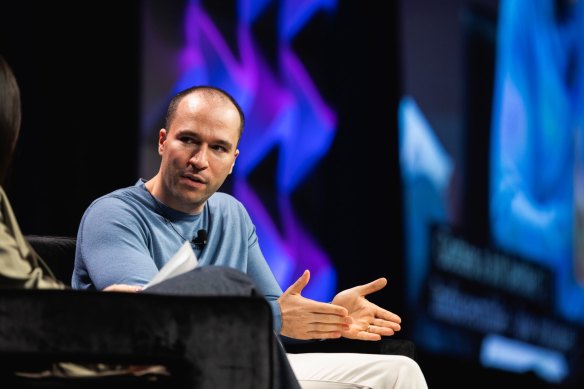This was published 1 year ago
Opinion
Sam’s out: The multibillion-dollar divide that drove the OpenAI coup
Stephen Bartholomeusz
Senior business columnistAt the heart of the turmoil that engulfed OpenAI, the parent company of the ChatGPT chatbot that ignited a frenzy of interest in artificial intelligence when it launched a year ago, appears to be competing visions for the development of artificial intelligence that are embedded in its corporate structure.
On Friday, OpenAI co-founder and chief executive Sam Altman was ousted by his own board, which accused him of “being not consistently candid in his communications and said it had lost confidence in his ability to lead the company.”

Sam Altman was left blindsided by the move, but there are rumblings that he could be reinstated.Credit: Bloomberg
Over the weekend, OpenAI’s investors, including Microsoft, which has invested about $US13 billion ($20 billion) in the group, were putting immense pressure on the board to reinstate Altman, who was apparently completely blindsided by the putsch.
Altman himself is reported to be open to returning, but only with a new board and a different governance structure.
OpenAI’s current governance structure is unusual, indeed probably unique.
The company was founded by Altman, Greg Brockman (who resigned as the company’s president on Friday in solidarity with Altman), OpenAI’s chief scientist Ilya Sutskever (who reportedly led the move to sack Altman) and Elon Musk (who quit ties with the group to pursue his own AI ambitions).
It was created as a not-for-profit, with a mission to “ensure that safe artificial general intelligence is developed and benefits all humanity,” a charter that recognised the considerable risks latent in AI. That charter was explicit in prioritising safety over profits.
Training and running large-scale AI models is horrendously expensive so, in 2019, Altman created an unusual for-profit entity within the group structure, with profits for investors capped at 100 times the size of their investment. The biggest investor is Microsoft, which owns 49 per cent of the commercial entity but has no board representation.
The for-profit entity also enabled OpenAI to compete with other tech companies for staff by offering them equity. The company was planning to raise $US1 billion to help employees sell their stock, an offer that implied the group was worth about $US86 billion.
It’s not just the corporate structure that’s unusual. The OpenAI board reflects the founding vision of safety over profits, with little if any commercial expertise, and more focused on the dangers of AI than maximising the value of what’s been described as the biggest business opportunity of the generation. Several board members have links with think tanks that fund projects aimed at preventing AI-generated risks to society.

OpenAI’s chief scientist Ilya Sutskever reportedly led the move to sack Altman.Credit: AFP
Altman, unlike his board, has been very focused on that opportunity. The ChatGPT platform already has more than 100 million monthly users and has partnered with, not just Microsoft, which is embedding AI in its products, but a range of large businesses and developers.
Altman has been scrambling, very successfully, to commercialise ChatGPT and keep ahead of the mega tech companies, like Google and Facebook, that have been galvanised by the extraordinary interest in AI that ChatGPT’s launch has ignited.
The speed at which he was moving and the scale of his ambitions seems to have collided with his board’s conviction, led by his chief scientist Sutskever, that development of safe AI should proceed cautiously. The non-profit’s directors thought he was elevating the pursuit of profit over management of the risks of AI.
A contributing factor to the collision of philosophies may have been Altman’s attempts to raise billions of dollars, some reports say as much as $US100 billion, from international venture capitalists and Middle Eastern sovereign wealth funds for two new projects.
The current generation of AI may not pose risks to humanity but AI is developing so quickly that those risks are already looming on the horizon.
He had been negotiating with semiconductor companies for an attempt to design new lower-cost chips for large-language models for AI that would compete with the current sole significant supplier, Nvidia.
He was also looking for investors in a new business building hardware devices for AI technologies like ChatGPT.
Whether those prospective new businesses were to be within the OpenAI structure or he was pursuing them on his own account is unclear, but the discussions do provide an indication of the pace at which he was moving and how out of kilter that was with the risk aversion of his board.
If Altman prevails over his board and returns to OpenAI it is inevitable that he will want to maintain the group’s lead over its competitors and turn the extraordinary value he’s helped create into something more accessible. He has no equity in the for-profit arm of OpenAI.

OpenAI co-founder Greg Brockman resigned as the company’s president on Friday in solidarity with Altman.Credit: Bloomberg
Otherwise, of course, he has the option of pursuing his AI ambitions independently. There would be no shortage of backers willing to help fund them.
The AI industry is in something of an arms race, among both commercial competitors and nations. The Biden administration has been adding layers of sanctions to try to prevent China, for instance, gaining access to the most advanced chips needed for AI.
That brings into focus the significance of the tension between the OpenAI board’s prioritisation of the safe development of the technology over its commercialisation.
The current generation of AI may not pose risks to humanity but AI is developing so quickly that those risks are already looming on the horizon.
Governments everywhere are enacting legislation or, as is the case in the US, entering voluntary agreements with AI developers as interim arrangements, to impose some restrictions on the perceived riskiest AI applications – facial recognition, the scraping of biometric data from social meda, its role in managing critical infrastructure, using AI to control access to public services and benefits and its potential ability to create and spread disinformation.
They want more transparency about the training data used to develop AI models, how the models make decisions and the consequences of those decisions.
Regulation of AI is, however, in its infancy and facing fierce opposition from the industry, which is more focused on the benefits AI can generate (and the profits) than the risks that pre-occupy regulators (and the OpenAI board).
Thus, the conflict within OpenAI that was exposed so abruptly on Friday reflects the larger dilemma over whether development of AI should be allowed to continue on its accelerating path without hindrance or whether it needs to be slowed and subjected to far greater scrutiny to ensure the increasingly powerful models do no calamitous harm.
The Business Briefing newsletter delivers major stories, exclusive coverage and expert opinion. Sign up to get it every weekday morning.